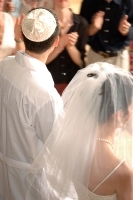
Learn about the meaningful traditions of Jewish weddings.
Jewish weddings symbolize the merging of two people into one soul. Read on to find out more about Jewish wedding traditions.
The Bride and the Groom
The chatan (Hebrew for groom) and kallah (bride) fast on the day of the festivities until the ceremony is over. At the ceremony, the chatan wears a kittel, the traditional white robe worn on Yom Kippur, an important Jewish holiday that means Day of Atonement.
It is customary for the bride and groom not to see one another before the ceremony. The couple greets their guests separately ? this event is called Kabbalat Panim. The bride receives her guests while seated on a throne, while the groom is surrounded by guests who sing and toast to him. At this time of greeting, one of the Jewish wedding traditions is for the mothers of the bride and groom to stand together and break a plate. This symbolizes commitment ? just as the plate can never be fully repaired, neither can a broken relationship.
The next step is the Badeken or the veiling of the kallah. The veil symbolizes modesty and holds the message that although attractiveness is an appreciated quality, the most important virtues one can hold are illustrated through character traits and the soul. The groom, accompanied by his family, approaches his bride and places the veil over her face. This ancient custom symbolizes a groom’s promise to clothe and take care of his wife.
~
The Ceremony
The wedding ceremony takes place underneath a chuppah or a canopy, which is the symbol of shelter or home. It is open on all sides to symbolize hospitality and a welcome to all guests. The chuppah is normally held outside and the bride and groom wear no jewelry beneath it. This symbolizes that their partnership is based on who they are ? not what material possessions they have. Under the chuppah, the groom circles the bride seven times. Just as the world was built in seven days, the groom is symbolically building the walls of the life he and his new bride will share together.
The blessings of marriage, or kiddushim, come next. After the blessings, the couple drinks from the same wine glass. Wine is a symbol of joy in the Jewish tradition.
Jewish wedding traditions include the giving of the ring. A marriage is not complete until the groom gives the bride something of value. In Jewish tradition, it is believed that the ring should be plain and gold without embellishments to symbolize the hope that the union, like the ring, will be made of simple beauty. The groom holds the ring in his hand and says, Behold, you are betrothed to me with this ring according to the law of Moses and Israel, and places the ring on the forefinger of his bride’s right hand. Now the couple is fully married.
The next step is the reading of the ketubah, or marriage contract. The document is signed by two witnesses and is considered a legal and binding agreement.
The second blessings are then read over a second glass of wine. This links the bride and groom in their belief in God as the creator of the world. The blessings are recited by a rabbi and other people that the couple would like to honor. At the end of the blessings, the bride and groom again drink from the same wine cup.
Next, a glass is placed on the floor, and the chatan breaks it with his foot. This serves as an example of the sadness resulting from the destruction of the temple in Jerusalem. Jews are always mindful ? even during happy moments ? that Jerusalem must be set above every joy. The breaking of the glass signifies the end of the ceremony and everyone says mazel tov, which means good luck or congratulations in Hebrew.
The Celebration
The couple is now led to a private room to spend a few moments alone together. This is referred to as Yichud. Afterwards, they break their fast with a celebratory meal. There is music and dancing as the new couple is celebrated.
It is customary, in the week following the wedding, for dinners to be thrown in honor of the bride and groom. This is referred to as The Week of Sheva Brachot, which means the week of seven blessings.
There are many Jewish wedding traditions, all of which make the ceremony rich in culture and meaning.
